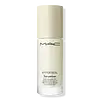What's inside
What's inside
 Key Ingredients
Key Ingredients

 Benefits
Benefits

 Concerns
Concerns

 Ingredients Side-by-side
Ingredients Side-by-side

Simmondsia Chinensis Seed Oil
EmollientCyclohexasiloxane
EmollientCyclopentasiloxane
EmollientMaris Aqua
HumectantEthyl Macadamiate
Skin ConditioningCetyl PEG/PPG-10/1 Dimethicone
EmulsifyingPropanediol
SolventIsodecyl Isononanoate
EmollientGlycerin
HumectantDiisobutyl Adipate
EmollientPvp
Emulsion StabilisingParfum
MaskingLinalool
PerfumingHexyl Cinnamal
PerfumingCitronellol
PerfumingGeraniol
PerfumingLimonene
PerfumingPentaerythrityl Tetra-Di-T-Butyl Hydroxyhydrocinnamate
AntioxidantMalic Acid
BufferingHypericum Perforatum Flower/Leaf/Stem Extract
Skin ConditioningOlea Europaea Fruit Oil
MaskingTocopherol
AntioxidantBorago Officinalis Seed Oil
EmollientHippophae Rhamnoides Fruit Oil
Skin ProtectingSimmondsia Chinensis Seed Oil, Cyclohexasiloxane, Cyclopentasiloxane, Maris Aqua, Ethyl Macadamiate, Cetyl PEG/PPG-10/1 Dimethicone, Propanediol, Isodecyl Isononanoate, Glycerin, Diisobutyl Adipate, Pvp, Parfum, Linalool, Hexyl Cinnamal, Citronellol, Geraniol, Limonene, Pentaerythrityl Tetra-Di-T-Butyl Hydroxyhydrocinnamate, Malic Acid, Hypericum Perforatum Flower/Leaf/Stem Extract, Olea Europaea Fruit Oil, Tocopherol, Borago Officinalis Seed Oil, Hippophae Rhamnoides Fruit Oil
Water
Skin ConditioningDimethicone
EmollientButylene Glycol
HumectantGlycerin
HumectantNiacinamide
SmoothingTrisiloxane
Skin ConditioningOctyldodecyl Stearoyl Stearate
EmollientTrehalose
HumectantPaeonia Albiflora Flower Extract
TonicCholesterol
EmollientCeramide Ng
Skin ConditioningLinoleic Acid
CleansingSalicylic Acid
MaskingLactic Acid
BufferingGlycolic Acid
BufferingCitric Acid
BufferingAlgae Extract
EmollientSaccharomyces Lysate Extract
HumectantBetula Alba Bark Extract
MaskingCamellia Sinensis Leaf Extract
AntimicrobialThermus Thermophillus Ferment
Skin ConditioningLaminaria Saccharina Extract
Skin ProtectingSilybum Marianum Extract
Skin ConditioningCaffeine
Skin ConditioningBis-PEG-18 Methyl Ether Dimethyl Silane
EmollientAcetyl Glucosamine
Skin ConditioningSodium Hyaluronate
HumectantSorbitol
HumectantSodium Magnesium Silicate
PEG-8
HumectantSucrose
HumectantT-Butyl Alcohol
PerfumingPolyacrylate Crosspolymer-6
Emulsion StabilisingOleth-10
EmulsifyingCarbomer
Emulsion StabilisingAmmonium Acryloyldimethyltaurate/Vp Copolymer
Xanthan Gum
EmulsifyingHydrogenated Lecithin
EmulsifyingJojoba Wax PEG-120 Esters
Sodium Hydroxide
BufferingTromethamine
BufferingDi-C12-18 Alkyl Dimonium Chloride
Skin ConditioningSilica
AbrasiveParfum
MaskingBenzyl Salicylate
PerfumingLimonene
PerfumingLinalool
PerfumingCI 77891
Cosmetic ColorantSynthetic Fluorphlogopite
Tin Oxide
AbrasiveMica
Cosmetic ColorantCaprylyl Glycol
EmollientBHT
AntioxidantDisodium EDTA
Hexylene Glycol
EmulsifyingTocopheryl Acetate
AntioxidantMagnesium Ascorbyl Phosphate
AntioxidantPhenoxyethanol
PreservativeSodium Benzoate
MaskingWater, Dimethicone, Butylene Glycol, Glycerin, Niacinamide, Trisiloxane, Octyldodecyl Stearoyl Stearate, Trehalose, Paeonia Albiflora Flower Extract, Cholesterol, Ceramide Ng, Linoleic Acid, Salicylic Acid, Lactic Acid, Glycolic Acid, Citric Acid, Algae Extract, Saccharomyces Lysate Extract, Betula Alba Bark Extract, Camellia Sinensis Leaf Extract, Thermus Thermophillus Ferment, Laminaria Saccharina Extract, Silybum Marianum Extract, Caffeine, Bis-PEG-18 Methyl Ether Dimethyl Silane, Acetyl Glucosamine, Sodium Hyaluronate, Sorbitol, Sodium Magnesium Silicate, PEG-8, Sucrose, T-Butyl Alcohol, Polyacrylate Crosspolymer-6, Oleth-10, Carbomer, Ammonium Acryloyldimethyltaurate/Vp Copolymer, Xanthan Gum, Hydrogenated Lecithin, Jojoba Wax PEG-120 Esters, Sodium Hydroxide, Tromethamine, Di-C12-18 Alkyl Dimonium Chloride, Silica, Parfum, Benzyl Salicylate, Limonene, Linalool, CI 77891, Synthetic Fluorphlogopite, Tin Oxide, Mica, Caprylyl Glycol, BHT, Disodium EDTA, Hexylene Glycol, Tocopheryl Acetate, Magnesium Ascorbyl Phosphate, Phenoxyethanol, Sodium Benzoate
 Reviews
Reviews

Ingredients Explained
These ingredients are found in both products.
Ingredients higher up in an ingredient list are typically present in a larger amount.
Glycerin is already naturally found in your skin. It helps moisturize and protect your skin.
A study from 2016 found glycerin to be more effective as a humectant than AHAs and hyaluronic acid.
As a humectant, it helps the skin stay hydrated by pulling moisture to your skin. The low molecular weight of glycerin allows it to pull moisture into the deeper layers of your skin.
Hydrated skin improves your skin barrier; Your skin barrier helps protect against irritants and bacteria.
Glycerin has also been found to have antimicrobial and antiviral properties. Due to these properties, glycerin is often used in wound and burn treatments.
In cosmetics, glycerin is usually derived from plants such as soybean or palm. However, it can also be sourced from animals, such as tallow or animal fat.
This ingredient is organic, colorless, odorless, and non-toxic.
Glycerin is the name for this ingredient in American English. British English uses Glycerol/Glycerine.
Learn more about GlycerinLimonene is a fragrance that adds scent and taste to a formulation.
It's found in the peel oil of citrus fruits and other plants such as lavender and eucalyptus. The scent of limonene is generally described as "sweet citrus".
Limonene acts as an antioxidant, meaning it helps neutralize free radicals.
When exposed to air, oxidized limonene may sensitize the skin. Because of this, limonene is often avoided by people with sensitive skin.
The term 'fragrance' is not regulated in many countries. In many cases, it is up to the brand to define this term. For instance, many brands choose to label themselves as "fragrance-free" because they are not using synthetic fragrances. However, their products may still contain ingredients such as essential oils that are considered a fragrance.
Learn more about LimoneneLinalool is a fragrance and helps add scent to products. It's derived from common plants such as cinnamon, mint, citrus, and lavender.
Like Limonene, this ingredient oxidizes when exposed to air. Oxidized linalool can cause allergies and skin sensitivity.
This ingredient has a scent that is floral, spicy tropical, and citrus-like.
Learn more about LinaloolParfum is a catch-all term for an ingredient or more that is used to give a scent to products.
Also called "fragrance", this ingredient can be a blend of hundreds of chemicals or plant oils. This means every product with "fragrance" or "parfum" in the ingredients list is a different mixture.
For instance, Habanolide is a proprietary trade name for a specific aroma chemical. When used as a fragrance ingredient in cosmetics, most aroma chemicals fall under the broad labeling category of “FRAGRANCE” or “PARFUM” according to EU and US regulations.
The term 'parfum' or 'fragrance' is not regulated in many countries. In many cases, it is up to the brand to define this term.
For instance, many brands choose to label themselves as "fragrance-free" because they are not using synthetic fragrances. However, their products may still contain ingredients such as essential oils that are considered a fragrance by INCI standards.
One example is Calendula flower extract. Calendula is an essential oil that still imparts a scent or 'fragrance'.
Depending on the blend, the ingredients in the mixture can cause allergies and sensitivities on the skin. Some ingredients that are known EU allergens include linalool and citronellol.
Parfum can also be used to mask or cover an unpleasant scent.
The bottom line is: not all fragrances/parfum/ingredients are created equally. If you are worried about fragrances, we recommend taking a closer look at an ingredient. And of course, we always recommend speaking with a professional.
Learn more about Parfum